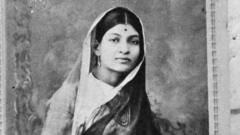On January 12, 1925, a seemingly routine car ride turned chaotic as a group of men attacked Abdul Kadir Bawla and his companion, Mumtaz Begum, in an upscale area of Bombay (now Mumbai). The brutal killing of Bawla, a prominent textile tycoon, sent shockwaves throughout colonial India and provoked extensive media coverage, stirring public interest and exposing the underlying tensions between the local Indian populace and British colonial powers.
Bawla, at just 25 years old, was not just a wealthy businessman but also the city’s youngest municipal official. His companion, Mumtaz Begum, age 22, was a courtesan who had escaped from the harem of the Maharaja of Indore, adding layers of intrigue to the tragedy. On that fateful evening, while driving along Malabar Hill, their vehicle was forced to stop by another car that collided with theirs. The attackers, armed and demanding the "lady" be removed from the car, shot Bawla, who died shortly thereafter despite the intervention of British soldiers nearby.
Investigations revealed threats had been made against Bawla for his relationship with Mumtaz Begum—a connection that was seen unfavorably by powerful political figures, particularly the Maharaja of Indore. This royal figure was deeply invested in safeguarding his authority, and evidence suggested the plot against Bawla was orchestrated from Indore itself, putting British officials in a precarious position due to the princely state’s significant bond with the British Raj.
The case gained notoriety as details unfolded; newspapers labeled it “the most sensational crime committed in British India,” leading to widespread gossip and speculation. As the investigation persisted, connections to the Maharaja’s court were unearthed. The culprits apprehended included individuals closely associated with the Indore administration, raising alarms among British officials regarding the implications of the crime on the stability of their governance.
The British colonial government was reluctant to confront the Maharaja directly but faced mounting pressure from various quarters, including Bawla’s wealthy community and Indian lawmakers, who demanded accountability. Despite the complexity and ensuing scrutiny, the trial concluded with convictions for several attackers, although the Maharaja was not held accountable, a decision criticized in the legal commentary that accompanied the case.
In a dramatic turn of events, faced with the ramifications of the investigation, Maharaja Tukoji Rao Holkar III chose to abdicate rather than face an inquiry into his potential involvement. He wrote to the British, officially stepping down and asserting that no further investigations would be pursued regarding his connections to the murder incident.
Post-abdication, the Maharaja created further controversy by marrying an American woman, leading to debates within his community about cultural integrity and loyalty. Meanwhile, Mumtaz Begum’s life took a different trajectory as she sought opportunities in Hollywood, though she ultimately faded from public view.
This stark murder case remains emblematic of the tumultuous intersection of love, power, and colonial dynamics in early 20th-century India, illustrating how personal lives were woven into the broader fabric of political strife and social intrigue. The Bawla murder serves as a historical lens through which the complexities of identity and authority in colonial India can be understood.



















